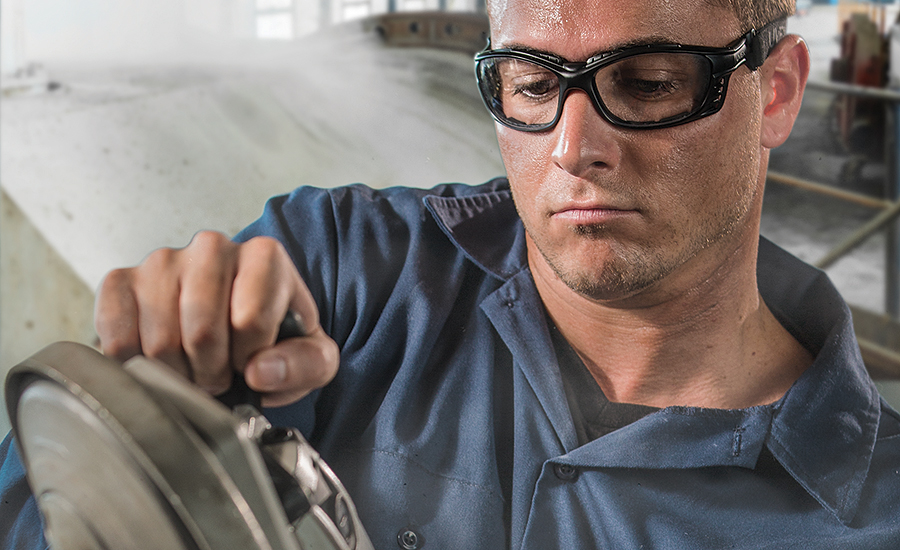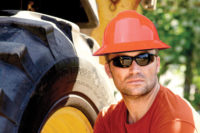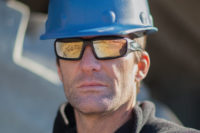Hazards to the eyes exist in nearly every industrial workplace. From flying fragments and splashing chemicals to harmful light and vapors, workers require safety eyewear to protect from a multitude of potential dangers. Yet in the summer, when the amount of work conducted outdoors surges, even more factors must be considered to ensure that eyewear stands up to harsh environmental demands.
Finding safety eyewear whose lenses protect from the sun’s harmful rays, minimize fogging and resist scratching is a tall order. Yet these benefits are proven to help support compliance, protect the workforce, increase productivity and promote visual longevity. By outfitting workers with high-performing lenses, employers stand to reduce the more than $467 million in direct occupational eye injury costs each year. This article offers tips for navigating safety lens options so the eyewear you select delivers optimum summer performance.
Lens performance plays a leading role in worker safety and compliance, and is measured in many ways.
Above all else, safety lenses must meet American National Standards Institute’s Z87.1 standard for impact protection. When lenses don’t stand up to impact, resulting eye injuries such as abrasions and punctures can lead to temporary or permanent blindness – even the loss of an eye. A first priority in selecting safety lenses and frames is to be sure they are marked with the ANSI standard to ensure impact protection.
In addition, safety lenses should deliver excellent optical clarity. When lenses are manufactured with even minor distortions, both workers and employers suffer. Distractions such as eyestrain, headaches and dizziness can lead to the removal of eyewear, which increases the risk of injury, and a decline in productivity. When selecting lenses, opt for those that provide an extremely clear view with no visible signs of distortion. Once the basic requirements for impact protection and optical clarity are met, safety managers should look toward protecting workers’ eyes from the various environmental hazards associated with outdoor work.
Protecting from natural light
A top consideration in lens performance for everyone working outside should be protection from the sun’s damaging visible and invisible rays. Long-term exposure as well as overexposure to invisible ultraviolet radiation significantly increases the likelihood of cataracts and can lead to skin cancer around the eye, macular degeneration and pterygium increase, a thickening of the outer corner of the eye which grows onto the cornea, impairing and sometimes blocking vision. Lenses need not be tinted to effectively block UV; many clear lenses provide ample protection. Whether tinted or not, be sure safety lenses deliver upwards of 99 percent protection from the UVA and UVB spectrums to avoid injury and long-term vision loss.
When tinted, safety lenses deliver added protection from other harmful rays as well. Exposure to the sun’s invisible infrared radiation, sensed as heat, can lead to cataracts, retinal burns and blindness, while visibly bright light and glare cause optical fatigue, redness, dryness and irritation, and also may cause permanent damage to the eyes. Varying work environments warrant different lens tints, which are designed to enhance visual perception and relieve eye strain in different job applications.
Standard espresso, gray and mirrored lenses may be selected based on worker preference to protect from many natural light hazards. However, in applications where intense glare exists from light reflecting off surfaces such as water, sand, glass, sheet metal or concrete, specialized tints should be employed. Mirrored, polarized or darkly tinted lenses are designed to combat intense natural light and glare.
For workers frequently transitioning between indoor and outdoor settings, variable, or photochromic, lenses are an ideal solution. Rather than carrying two pairs of eyewear or conducting indoor work in darkly tinted lenses, variable lenses quickly transition from dark to light based on the UV light present. By understanding their functions and using them appropriately, lens tints can greatly reduce eye injuries on the job and increase workers’ productivity and longevity of vision.
Combating fog
Another aspect of safety lens performance that plays a leading role in worker safety is the ability to combat fog. Caused by environmental heat and humidity, worker exertion, transitions between warm and cool environments, and frequent washing, fog is nearly impossible to avoid when working outdoors in the summer. In fact, fogging is the number one problem faced by safety eyewear users.
When lenses fog, individuals continue to work despite their obscured vision – with potentially catastrophic results. It only takes a second for an accident to occur: a misstep, slip or fall; contact with machinery; getting struck by equipment; or coming into contact with chemicals or electrical current.
Alternatively, workers may remove foggy eyewear to wipe lenses clean. If this is done on-site, they leave themselves vulnerable to injury; if conducted off-site, productivity suffers.
Anti-fog lens coating directly impacts worker safety by helping individuals maintain safe, fog-free vision in the workplace. Be aware that different manufacturers’ coatings work in different ways, with varying levels of success and longevity.
Manufacturers of high performance anti-fog coatings employ special formulations for longer-lasting protection; apply a controlled layer of coating to absorb more moisture; utilize an intense curing process for greater coating longevity; and apply the coating in a clean, controlled environment so as not to disrupt lens optics.
When considering anti-fog lens coatings, look for proven technologies that deliver the longest-lasting fog-free vision and durable staying power that won’t wash off even after repeated wiping and cleaning. Workers face a variety of hazards in extreme summertime conditions, and their anti-fog protection should live up to the rigors of these demanding environments.
Resisting scratches
Finally, the safety lens’s ability to resist scratches is another important aspect to consider. With summer’s hot, dry, windy conditions comes a higher propensity for flying dust, sand, debris, and fragments to come in contact with lenses and cause scratching. Once scratched, lenses no longer afford the wearer a clear or comfortable view of the workplace and hazards, and should be replaced. To combat scratching, scuffing and a variety of chemicals, and to prolong safety lens life, look for eyewear with a proven, long-lasting scratch-resistant hardcoat.
When selecting safety eyewear for the outdoor workforce in summer, many environmental factors should be weighed. By understanding the benefits of different lens designs, tints and coatings, you can make decisions with confidence. Outfitting workers with high-performing eyewear that meets ANSI standards, protects from natural light hazards, minimizes fogging, reduces scratching and encourages compliance.






